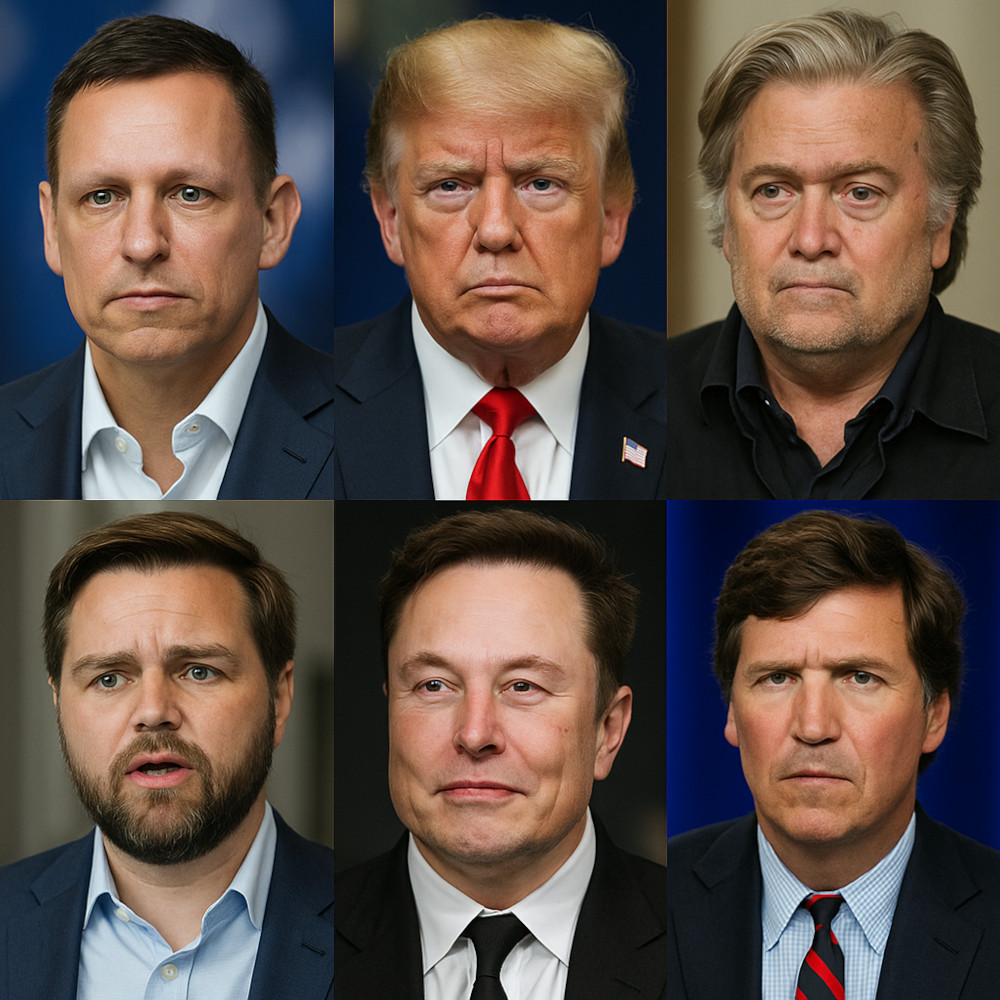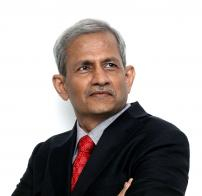Left to right (top row): Peter Thiel, Donald Trump, Steve Bannon.
Bottom row: JD Vance, Elon Musk, Tucker Carlson.
Note: Visual tile generated using OpenAI’s ChatGPT. This is an AI-assisted composite illustration and is not intended to be an exact replica of the original photographs.
Editor’s Note
As this column goes to press, AI has triggered the first major split of the Trump era—not just within the MAGA movement, but between the federal government and several states. President Trump has asked the Attorney General to establish an AI Litigation Task Force to challenge state-level laws addressing extreme risks from advanced AI models, and has even suggested that federal funds could be withheld from states pursuing such legislation. This constitutional confrontation forms the first axis of division.
The second axis—the internal churn within the MAGA movement—is the subject of Sundeep Waslekar’s analysis below.
The Make America Great Again (MAGA) movement is showing signs of internal strain as the United States heads toward the Congressional elections in November 2026. Whether these tensions merely confuse Republican voters or lead to a deeper rupture remains unclear. What is certain is that the once-unified force behind Donald Trump is now wrestling with its identity. At the heart of the debate lie three issues central to America’s future: artificial intelligence, H-1B visas, and the country’s role in global wars.
For most of its existence, MAGA projected ideological cohesion: nationalist, anti-establishment, culturally conservative, and anchored in Trump’s persona. But as technology, immigration, and geopolitics assume greater political weight, internal differences have become harder to conceal. Instead of a clean split, a multi-sided debate is emerging over what “America First” means in an age of rapid technological change.
How MAGA’s tech alliance began
The origins of the MAGA - Silicon Valley equation go back to December 14, 2016, when Trump met Peter Thiel and a select group of tech leaders on the 25th floor of Trump Tower. Thiel sat beside Trump as Tim Cook, Jeff Bezos, Satya Nadella, Sheryl Sandberg, Larry Page, Sergey Brin and Elon Musk joined the table. For Thiel, “Again” in Make America Great Again meant reviving America’s scientific ambition after what he saw as decades of stagnation. The meeting signalled a shift towards closer engagement between the new administration and the technology sector, even though many in Silicon Valley remained wary of Trump’s broader agenda.
A decade later, this uneasy alignment has splintered into three distinct currents.
The Accelerationists
This camp is symbolised by Peter Thiel. Although no longer active in daily political strategy, he remains influential in conservative intellectual and donor circles. Accelerationists argue that the United States must pursue rapid, even aggressive, AI development to retain global leadership. For them, whoever leads in artificial general intelligence will set the rules of the future global order. They also favour openness to highly skilled immigration, especially in research and frontier technologies.
The Sceptics
At the other end lies a current represented by Steve Bannon, who surprised many by signing an international appeal calling for a pause in the development of superintelligent AI. Though Bannon’s personal influence has receded—one prominent MAGA voice described him to this author as “nobody”—his stance captures a deeper mistrust within the movement. This wing fears that advanced AI will concentrate power in the hands of unelected corporate elites, weaken national sovereignty, and destabilise society. It strongly opposes foreign skilled visas, seeing them as undercutting American workers and serving the interests of Big Tech.
The Nationalist-Pragmatists
Between these poles sits a growing faction shaped by Vice President JD Vance, a Thiel protege. Vance supports American leadership in AI but insists it must reinforce national resilience, protect sovereignty, and reduce dependence on foreign supply chains. He neither endorses Thiel’s unrestrained accelerationism nor supports Bannon’s call for a pause. His argument: the US must advance AI fast enough to maintain global advantage, manage risks through public oversight, and build domestic talent to reduce long-term reliance on imported skills. His evolving doctrine reflects an attempt to craft a coherent post-Trump conservative technology agenda.
The Flashpoint: Immigration
When Trump recently suggested that the United States should welcome “the best and the brightest,” including highly skilled immigrants, the reaction inside MAGA was immediate and fierce. Marjorie Taylor Greene publicly denounced the idea and repeated her demand to abolish the H-1B programme altogether. Her stance resonates with factions that believe foreign tech workers depress wages—and that rapid advances in AI will soon reduce the need for imported programming talent.
Elon Musk occupies a more ambiguous position, warning about the dangers of AI even as he aggressively invests in it. His views, though widely discussed, do not coalesce into a coherent faction.
Tucker Carlson adds a different dimension. He does not oppose AI on technical grounds; instead, he frames it as a potential instrument of social control if dominated by corporate or bureaucratic elites. His warnings about concentrated power resonate strongly with the MAGA base and often shape public sentiment more than formal policy proposals.
Although Bannon is no longer central, his signature on the AI-pause appeal underscores an undercurrent of mistrust: a fear of technologies perceived as operating beyond democratic accountability. He did not originate this sentiment; he merely articulated a view already taking root within the movement’s populist wing.
Why the World is Watching
The outcome of this internal MAGA contest will influence talent flows, AI investment, regulatory norms, and supply-chain alliances far beyond US borders.
China is observing closely as it works to build domestic alternatives to Nvidia and ASML. While it remains behind the US in many top-end chip manufacturing processes, its pace of catch-up is notable and a source of strategic anxiety in Washington. South Korea, with its strong R&D base, could see significant advances in scientific AI—something observers believe may become visible over the next year.
The UAE, still dependent on the American AI stack, is positioning itself as a hub for AI safety and scientific AI, with Saudi Arabia likely to follow.
India signalled a major step on 3 November 2025 by announcing a $12-billion Research, Development and Innovation Fund and indicating a heightened concern about the risks posed by advanced AI. Whether this becomes transformative will depend on how India’s private sector and scientific community harness these resources for real and safe deep-tech innovation.
Across Beijing, Abu Dhabi, Riyadh and New Delhi, policymakers are watching JD Vance closely. He views AI as a cornerstone of national competitiveness but insists it must strengthen American workers and national resilience. His approach is quieter than the movement’s louder voices, yet it is gaining respect within conservative policymaking circles.
If MAGA is to craft a coherent technological doctrine in the years ahead, the man loyal to both Trump and Thiel may well shape America’s next decade.


